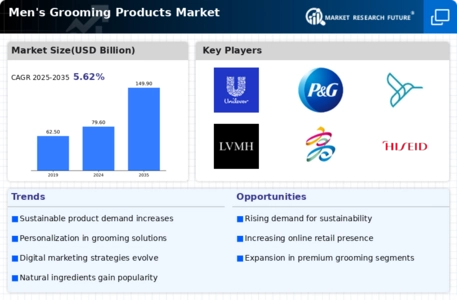Rise of E-commerce Platforms
The proliferation of e-commerce platforms is transforming the Men's Grooming Products Market, providing consumers with unprecedented access to a wide array of grooming products. Online shopping has become increasingly popular, particularly among younger demographics who prefer the convenience and variety that e-commerce offers. Data suggests that online sales of men's grooming products are expected to account for over 30% of total sales by 2025. This shift towards digital shopping is further supported by advancements in technology, such as augmented reality tools that allow consumers to virtually try products before purchasing. As e-commerce continues to expand, it is likely to reshape the purchasing habits of male consumers, driving growth in the grooming sector.
Innovation in Product Offerings
Innovation plays a crucial role in the Men's Grooming Products Market, as brands continuously develop new and improved products to meet the evolving needs of male consumers. The introduction of multifunctional products, such as all-in-one grooming kits and skincare lines specifically designed for men, has gained traction. This innovation is supported by market data indicating that the men's skincare segment alone is expected to grow at a CAGR of 6.5% from 2023 to 2030. Companies are also focusing on sustainable and eco-friendly formulations, which appeal to environmentally conscious consumers. As brands innovate, they not only enhance their product lines but also create a competitive edge in a crowded marketplace.
Increasing Male Grooming Awareness
The growing awareness among men regarding personal grooming is a pivotal driver in the Men's Grooming Products Market. As societal norms evolve, more men are embracing grooming routines that were traditionally associated with women. This shift is reflected in the increasing sales of grooming products, with the market projected to reach approximately 166 billion USD by 2026. The rise in male grooming awareness is not merely a trend; it indicates a fundamental change in consumer behavior, where men are now more inclined to invest in skincare, haircare, and other grooming essentials. This heightened awareness is further fueled by social media influencers and advertising campaigns that promote self-care and grooming as essential components of modern masculinity.
Influence of Celebrity Endorsements
Celebrity endorsements have a profound impact on the Men's Grooming Products Market, as high-profile figures promote grooming products to their vast audiences. The association of grooming products with well-known personalities enhances brand visibility and credibility, leading to increased consumer interest and sales. Market analysis indicates that brands leveraging celebrity endorsements experience a notable uptick in sales, with some reporting increases of up to 20% following a campaign launch. This trend underscores the importance of marketing strategies that incorporate influential figures, as they can effectively shape consumer perceptions and drive purchasing decisions. As the market evolves, the role of celebrities in promoting grooming products is likely to remain a key driver.
Growing Demand for Male-Specific Products
The growing demand for male-specific grooming products is a significant driver in the Men's Grooming Products Market. As men become more discerning about their grooming needs, there is an increasing preference for products tailored specifically for them, such as beard oils, specialized shampoos, and skincare lines. This trend is supported by market data indicating that the male grooming segment is expected to grow at a CAGR of 5.8% through 2027. The rise in demand for male-specific products reflects a broader cultural shift towards recognizing men's grooming as an essential aspect of personal care. Brands that cater to this demand are likely to find substantial opportunities for growth in an increasingly competitive landscape.






















Leave a Comment